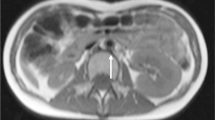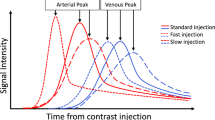Abstract
Non-contrast magnetic resonance (MR) angiography and MR venography techniques are gaining popularity for vascular imaging because they are faster, more forgiving and less costly compared with contrast-enhanced MR angiography. Non-contrast MR angiography also avoids gadolinium deposition, which is especially important in imaging children. Non-contrast MR angiography has an array of specific applications for numerous clinical indications. This review summarizes the non-contrast MR angiography methods and their relative advantages and disadvantages. The paper also guides the reader on which technique to consider when determining the optimal imaging modality for each individual patient.
















Similar content being viewed by others
References
Miyazaki M, Lee VS (2008) Nonenhanced MR angiography. Radiology 248:20–43
Edelman RR, Koktzoglou I (2019) Noncontrast MR angiography: an update. J Magn Reson Imaging 49:355–373
McDonald RJ, McDonald JS, Kallmes DF et al (2015) Intracranial gadolinium deposition after contrast-enhanced MR imaging. Radiology 275:772–782
Lord ML, Chettle DR, Grafe JL et al (2018) Observed deposition of gadolinium in bone using a new noninvasive in vivo biomedical device: results of a small pilot feasibility study. Radiology 287:96–103
Ponrartana S, Moore MM, Chan SS et al (2021) Safety issues related to intravenous contrast material use in magnetic resonance imaging. Pediatr Radiol. https://doi.org/10.1007/s00247-020-04896-7
Vanaerde O, Budzik JF, Mackowiak A et al (2017) Comparison between enhanced susceptibility-weighted angiography and time of flight sequences in the detection of arterial occlusion in acute ischemic stroke. J Neuroradiol 44:210–216
Greil GF, Seeger A, Miller S et al (2007) Coronary magnetic resonance angiography and vessel wall imaging in children with Kawasaki disease. Pediatr Radiol 37:666–673
Scheffler K, Hennig J (2003) Is TrueFISP a gradient-echo or a spin-echo sequence? Magn Reson Med 49:395–397
Scheffler K, Lehnhardt S (2003) Principles and applications of balanced SSFP techniques. Eur Radiol 13:2409–2418
Seeger A, Fenchel MC, Greil GF et al (2009) Three-dimensional cine MRI in free-breathing infants and children with congenital heart disease. Pediatr Radiol 39:1333–1342
Markl M, Alley MT, Elkins CJ et al (2003) Flow effects in balanced steady state free precession imaging. Magn Reson Med 50:892–903
Miyazaki M, Takai H, Sugiura S et al (2003) Peripheral MR angiography: separation of arteries from veins with flow-spoiled gradient pulses in electrocardiography-triggered three-dimensional half-Fourier fast spin-echo imaging. Radiology 227:890–896
Saloner D (1995) The AAPM/RSNA physics tutorial for residents. An introduction to MR angiography. Radiographics 15:453–465
Landgraf BR, Johnson KM, Roldan-Alzate A et al (2014) Effect of temporal resolution on 4D flow MRI in the portal circulation. J Magn Reson Imaging 39:819–826
Dyverfeldt P, Bissell M, Barker AJ et al (2015) 4D flow cardiovascular magnetic resonance consensus statement. J Cardiovasc Magn Reson 17:72
Markl M, Frydrychowicz A, Kozerke S et al (2012) 4D flow MRI. J Magn Reson Imaging 36:1015–1036
Edelman RR, Carr M, Koktzoglou I (2019) Advances in non-contrast quiescent-interval slice-selective (QISS) magnetic resonance angiography. Clin Radiol 74:29–36
Elster AD (2020) Inflow balanced-SSFP with IR saturation. Web page. http://mriquestions.com/inflow-enhanced-ssfp.html. Accessed 23 Feb 2021
Bultman EM, Klaers J, Johnson KM et al (2014) Non-contrast enhanced 3D SSFP MRA of the renal allograft vasculature: a comparison between radial linear combination and Cartesian inflow-weighted acquisitions. Magn Reson Imaging 32:190–195
Dillman JR, Trout AT, Merrow AC et al (2019) Non-contrast three-dimensional gradient recalled echo Dixon-based magnetic resonance angiography/venography in children. Pediatr Radiol 49:407–414
Yoneyama M, Zhang S, Hu HH et al (2019) Free-breathing non-contrast-enhanced flow-independent MR angiography using magnetization-prepared 3D non-balanced dual-echo Dixon method: a feasibility study at 3 tesla. Magn Reson Imaging 63:137–146
Wheaton AJ, Miyazaki M (2012) Non-contrast enhanced MR angiography: physical principles. J Magn Reson Imaging 36:286–304
Shimada K, Nagasaka T, Shidahara M et al (2012) In vivo measurement of longitudinal relaxation time of human blood by inversion-recovery fast gradient-echo MR imaging at 3T. Magn Reson Med Sci 11:265–271
Fan Z, Sheehan J, Bi X et al (2009) 3D noncontrast MR angiography of the distal lower extremities using flow-sensitive dephasing (FSD)-prepared balanced SSFP. Magn Reson Med 62:1523–1532
Author information
Authors and Affiliations
Corresponding author
Ethics declarations
Conflicts of interest
Dr. Chan is a consultant for and receives publishing and grant support from Jazz Pharmaceuticals. Dr. Chan also has patent co-ownership with Children’s Mercy Hospital and receives in-kind research support from Hyperline.
Additional information
Publisher’s note
Springer Nature remains neutral with regard to jurisdictional claims in published maps and institutional affiliations.
Rights and permissions
About this article
Cite this article
Fleecs, J.B., Artz, N.S., Mitchell, G.S. et al. Non-contrast magnetic resonance angiography/venography techniques: what are my options?. Pediatr Radiol 52, 271–284 (2022). https://doi.org/10.1007/s00247-021-05067-y
Received:
Revised:
Accepted:
Published:
Issue Date:
DOI: https://doi.org/10.1007/s00247-021-05067-y




